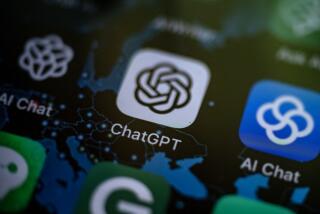Artificially created cell called a scientific feat
- Share via
In a major step toward the creation of artificial life, researchers announced Thursday that they’ve created the first cell controlled entirely by DNA assembled from laboratory chemicals.
Molecular biologist J. Craig Venter, the primary author of the report detailing the findings, described the converted cell as “the first self-replicating species we’ve had on the planet whose parent is a computer.”
The achievement is notable both from a scientific standpoint and from a practical one, said microbiologist Clyde Hutchison of the J. Craig Venter Institute in La Jolla, a co-author of the paper. “From a practical aspect, this should enable building cells that have things added that will help with a variety of social needs.”
The institute is already working with funding from BP and Exxon to create biofuels that would reduce our dependence on petroleum. It is also trying to develop bacteria that could gobble up oil spills like that in the Gulf of Mexico. Experts speculate that it may be possible to develop organisms that produce vaccines, pharmaceuticals and other desirable chemicals.
Other researchers have made microorganisms that can achieve such feats by tweaking existing microbes with one or two added genes. But a purpose-designed organism created from scratch would presumably be much more efficient, and it should be easier to control its products.
Experts said, however, that it would be at least five years before such organisms could be created. “There are major hurdles that need to be overcome first,” said molecular geneticist Paul Keim of Northern Arizona University. The most serious one is getting all the added genes to work together. The genome Venter copied “was already a product of millions of years of evolution, and nature had already tweaked the interactions between genes.”
“This is a tour de force and a landmark paper … that is akin to Jurassic Park or Frankenstein,” said Dr. Anthony C. Forster, a molecular biologist at Vanderbilt University who is an expert in the field of artificial life forms. “I think it will probably be regarded as the dawn of synthetic genomics.”
Neither Keim nor Forster were involved in the new research.
Although most scientists overwhelmingly praised the achievement, reported online by the journal Science, some environmental groups warned against unforeseen consequences, similar to those expressed about genetically modified food or other bio-engineered products.
Friends of the Earth called on governmental agencies to begin regulating synthetic biology experiments. The technology watchdog Action Group on Erosion, Technology and Concentration, or ETC Group, a Canadian organization concerned about the effects of new technologies on marginalized peoples, went even further, calling for a moratorium on the work.
“The government and society in general are not ready for self-replicating artificial life forms,” said ETC Executive Director Pat Mooney. “There hasn’t been adequate monitoring of this while it was being developed. It’s being born into this environment where there is no real regulation and no understanding of it.”
But, in this case, the artificially created cell — a bacterium — did not have any unusual characteristics, because the inserted DNA was a chemical copy of an existing genome.
The new results reported by Venter and his colleagues did not surprise people who monitor developments in artificial life. Venter, best known for his work on decoding the human genome, has been inching toward this point for years.
Their first major step occurred in 2007 when the team removed the genome from one bacterium and transplanted into a microbe of a different species. The recipient, which had been stripped of its own genome, then behaved like the donor species. Learning how to do that was the key step in the process, Hutchison said.
A year later, the researchers showed that they could add marker genes to the donated genome of Mycoplasma genitalium so they could identify it accurately in daughter cells.
To complete the project, they sequenced the genome of Mycoplasma mycoides. Last year, they showed that they could modify the M. mycoides DNA to carry markers that would allow them to track it after it had been inserted into another bacterium, the related species, M. capricolum.
The researchers then ordered fragments of DNA from the M. mycoides genome from a company that synthesized the fragments from laboratory chemicals. They assembled the fragments into a complete genome, and, to further identify the material, they inserted sequences of DNA that, in code, contained an e-mail address for the project, the names of several participants and a selection of famous quotations. They also inserted a gene that would cause the cells to turn blue.
After much work, they succeeded in inserting the synthetic M. mycoides genome into M. capricolum from which all DNA had been removed, and they got the bacterium to grow. The host bacterium made proteins characteristic of M. mycoides and otherwise behaved just like it.
Meanwhile, it is highly unlikely that the technology could be put to use by terrorists because of the great cost and the amount of time required — about $40 million so far over 15 years.






